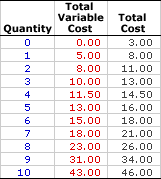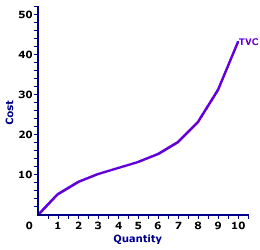
|
|
X: The standard abbreviation for exports produced by the foreign sector and purchased by the domestic economy, especially when used in the study of macroeconomics. This abbreviation is most often seen in the aggregate expenditure equation, AE = C + I + G + (X - M), where C, I, G, and (X - M) represent expenditures by the four macroeconomic sectors, household, business, government, and foreign. The United States, for example, sells a lot of the stuff produced within our boundaries to other countries, including wheat, beef, cars, furniture, and, well, almost every variety of product you care to name.
Visit the GLOSS*arama
|
|


|

|
                           TOTAL VARIABLE COST: Cost of production that does change with changes in the quantity of output produced by a firm in the short run. Total variable cost is one part of total cost. The other is total fixed cost. Variable cost depends on the level of output. If a firm produces more output, then variable cost is greater. If a firm produces no output, then variable cost is zero. A cost measure directly related to total variable cost is average variable cost. Total variable cost is the opportunity cost incurred in the short-run production that depends on the quantity of output. As the name clearly implies, total variable cost is variable, it changes. If a firm produces a little output, then total variable cost is less. If a firm produces a lot of output, then total variable cost is more.A firm can avoid variable cost in the short run by reducing production to zero. This bit of information often comes in handy when the price received by a firm is so low that it falls short off covering variable cost at any positive quantity of production. As such, the firm might find it most "profitable" to cut losses by shutting down production and avoiding variable cost, until the price increases. Variable InputsTotal variable cost is usually, not always but usually, associated with inputs that are variable in the short run. For example, The Wacky Willy Company operates in the short run with labor (the workers) as a variable input and capital (the building and equipment) as a fixed input. The cost associated with labor is a prime candidate to be a variable cost. This includes hourly wage payments to the workers and any hourly fringe benefits paid on behalf of the workers.While labor is usually isolated as THE variable input in the short run, most short-run production has other variable inputs, too. The Wacky Willy Company uses an assortment of other variable inputs, all of which are part of variable cost--including cuddly cloth, squeezeably soft stuffing, and thread that make up the Stuffed Amigos; electricity needed to run the machinery; and boxes, plastic wrapping, and other packing materials used to ship the Stuffed Amigos to customers. When The Wacky Willy Company makes more Stuffed Amigos, they incur a greater cost for these variable inputs. The Cost of Stuffed Amigos| Total Variable Cost |  |
The table to the right summarizes the total variable cost of producing Wacky Willy Stuffed Amigos. The left-hand column is the quantity of Stuffed Amigos coming off the assembly line each minute, ranging from 0 to 10. For reference, the right-hand column is the total cost of producing Stuffed Amigos, the combination of total variable and total fixed cost.The center column is the total variable cost of producing each quantity, which is exactly $0 if no Stuffed Amigos are produced and rises to $43 if 10 Stuffed Amigos are produced. This is the essence of variable cost. Greater production entails greater total variable cost. - The most obvious point is that total variable cost increases with increased production. Producing more Stuffed Amigos means higher total variable cost. This makes sense. To produce more Stuffed Amigos, The Wacky Willy Company needs to hire more labor and buy more materials. Because these inputs incur a cost, total variable cost rises with extra production.
- Moreover, total variable cost is zero when no Stuffed Amigos are produced. The Wacky Willy Company incurs no variable cost when they employ no workers and buy no materials--their variable inputs.
- A last note is that the incremental increase in total variable cost is NOT the same for each quantity. In other words, total variable cost does not rise at a constant rate. This incremental change in total variable cost reflects marginal cost, a key concept in the short-run production and supply decision of a firm.
The Total Variable Cost Curve| Total Variable Cost Curve |  |
The total variable cost curve graphically represents the relation between total variable cost incurred by a firm in the short-run product of a good or service and the quantity produced. The total variable cost curve (TVC) for Wacky Willy Stuffed Amigos production is illustrated in the graph to the right. Because total variable cost increases with the quantity produced, the total variable cost curve has a positive slope. The most striking feature of the total variable cost curve is its shape. The total variable cost curve emerges from the origin, then twists and turns its way to $43. This curve begins relatively steep, then flattens, before turning increasingly steep once again. The slope of the total variable cost curve flattens as the first four Stuffed Amigos are produced due to increasing marginal returns found in Stage I of production. The slope of the total variable cost curve becomes increasingly steeper after the fourth Stuffed Amigo is produced. This range of output corresponds with decreasing marginal returns, and the extremely important law of diminishing marginal returns, found in Stage II of production. Average Variable CostTotal variable cost can be used to derive a related variable cost concept--average variable cost. Average variable cost is simply variable cost per unit of output, which can be found by dividing total variable cost by the quantity of output. If, for example, total variable cost is $43 and the quantity of output produced is 10 Stuffed Amigos, then average variable cost, that is the variable cost per unit produced, is $4.30 (= $43/10).The connection between total variable cost and average variable cost is mathematically represented by this equation: | average variable cost | = | total variable cost
quantity of output |
A Fixed AlternativeTotal variable cost is one of two components of total cost. The other is total fixed cost. Total fixed cost is the opportunity cost incurred in the short-run production by a firm that does NOT depend on the quantity of output. A firm can produce a little output or a lot, increase or decrease production, or even stop producing altogether, but fixed cost remains unchanged. Total fixed cost is closely connected to the use of fixed inputs. This means that total fixed cost is unaffected by the law of diminishing marginal returns. The connection between total cost, total variable cost, and total fixed cost is often summarized in this handy equation: | total cost | = | total fixed cost + total variable cost |

Recommended Citation:TOTAL VARIABLE COST, AmosWEB Encyclonomic WEB*pedia, http://www.AmosWEB.com, AmosWEB LLC, 2000-2025. [Accessed: July 1, 2025].
Check Out These Related Terms... | | | | | | | | | | | | |
Or For A Little Background... | | | | | | | | | | | | |
And For Further Study... | | | | | | | | | | | |
Search Again?
Back to the WEB*pedia
|



|

|
BEIGE MUNDORTLE
[What's This?]
Today, you are likely to spend a great deal of time touring the new suburban shopping complex looking to buy either a genuine down-filled pillow or one of those "hang in there" kitty cat posters. Be on the lookout for defective microphones.
Your Complete Scope
This isn't me! What am I?
|

|
|
The Dow Jones family of stock market price indexes began with a simple average of 11 stock prices in 1884.
|

|
|
"Experience keeps a dear school, but fools will learn in no other. " -- Benjamin Franklin
|

|
CAP
Common Agricultural Policy
|

|
|
Tell us what you think about AmosWEB. Like what you see? Have suggestions for improvements? Let us know. Click the User Feedback link.
User Feedback
|


|


